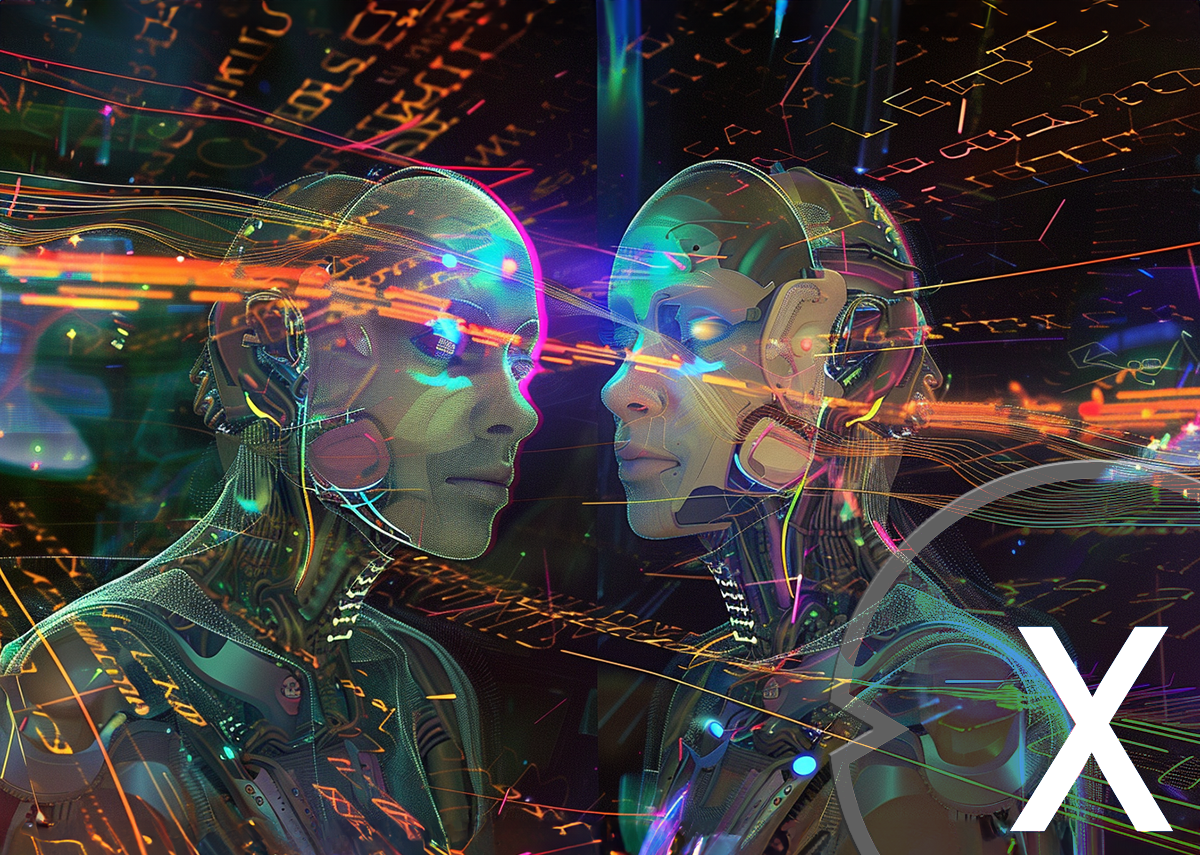Multimodular or multimodal AI? Spelling mistake or actually a difference? How is multimodal AI different from other AI?
Language selection 📢
Published on: September 28, 2024 / update from: September 28, 2024 - Author: Konrad Wolfenstein

Multimodular or multimodal AI? Spelling mistake or actually a difference? How is multimodal AI different from other AI? – Image: Xpert.Digital
🔍 How is multimodal AI different from other AI? 🧠✨
🤔🧠 Artificial intelligence (AI) is developing at a rapid pace, and with this development new terms and concepts are constantly emerging that can seem confusing at first glance. An example of this is the difference between “multimodular” and “multimodal” AI. Is this a misspelling or is there actually a significant difference between these two terms? Below we take a closer look at both concepts, examining what sets them apart and why they play an important role in modern AI development.
📊 Multimodal AI – A definition
Multimodal AI refers to an artificial intelligence capable of processing and combining information from different sources or “modes”. These modes can include visual data (such as images and videos), auditory information (such as speech or music), textual data, and other sensory inputs. The goal of a multimodal AI is to expand the capabilities of the machine by being able to understand and process information from different sensory channels simultaneously.
A good example of multimodal AI is a system that can analyze both images and text to provide a more comprehensive answer. Let's say a user shows a picture of a dog and asks, "What breed is this?" A multimodal AI could analyze the image of the dog and compare it to a database to identify the correct dog breed, while also understanding the text to interpret the user's specific request.
🌟 Why multimodal AI is important
In the real world, we do not experience our surroundings in isolation through a single sense. We see, hear, feel and interact with the world in different ways. This ability to combine different sensory information allows us to understand complex situations. For example, in a conversation we perceive the words of the other person as well as their body language, facial expression and tone of voice in order to correctly interpret the meaning.
Multimodal AI seeks to develop similar capabilities. By integrating different types of data, AI can gain a more comprehensive understanding of situations, contexts and tasks. This has huge potential in various areas, from healthcare to autonomous vehicles. For example, medical diagnostic tools could evaluate both imaging procedures and patient interviews to make a more precise diagnosis.
🚀 Advances in multimodal AI
In recent years there have been significant advances in the development of multimodal AI models. These advances are due in part to new technological developments in the field of machine learning, particularly advances in neural networks and the availability of large, multimodal data sets.
A well-known example of a multimodal AI model is GPT-4 from OpenAI, which can process both text and images. Such models are able to analyze text, access visual information, and combine it together to generate answers based on a deeper level of understanding. These capabilities can be used in a variety of applications, such as creating image descriptions, assisting people with visual impairments, or analyzing complex scenarios in scientific or technical fields.
🛠️ Multimodular AI – Another concept?
Unlike multimodal AI, which refers to processing multiple types of data sources, the term “multimodular AI” indicates an AI architecture that consists of multiple modules. Each of these modules is specialized for its specific task or function, and the entire system handles more complex tasks by combining the different modules.
Although “multimodular AI” is not as widely used in the literature as “multimodal AI,” there are numerous modular approaches to AI development. In modular systems, various specialized algorithms or AI components are developed for specific tasks. A typical example would be an autonomous vehicle that has various modules for image recognition, decision making, motion planning and control. Each of these modules works independently, but the vehicle as a whole uses the results of all modules to drive safely.
🔧 Advantages of a modular AI approach
The modular approach in AI has several advantages. First, it makes it possible to develop specialized solutions for specific problems. Instead of building a monolithic AI system that has to handle every task, developers can optimize individual modules for specific functions. This often leads to better results because each module can be tailored precisely to its task.
Secondly, the modular approach offers greater flexibility. If a specific module needs to be improved or replaced, this can be done without overhauling the entire system. This makes maintenance and further development of the system easier.
Third, the modular approach allows for better error localization and resolution. Because each module works in isolation, a problem in a specific module can be more easily identified and resolved without affecting the entire system.
🔍 Multimodal vs. Multimodular – What’s the difference?
Multimodal AI and multimodular AI represent two different approaches or concepts. Multimodal AI refers to the ability to combine information from different sources or modes to gain a more comprehensive understanding. Multimodular AI, on the other hand, refers to an architecture where different specialized modules work together to handle complex tasks.
Both approaches have their own strengths and potential, and it is quite possible that future AI systems will combine both approaches to become even more powerful. For example, a system could be multimodal, processing information from different data sources, while being modular to perform specialized functions more efficiently.
🚨 The future of multimodal AI
Multimodal AI is expected to play an increasingly larger role in the coming years as the technology makes inroads into various areas. Applications range from improved image and text processing to advanced assistance systems that can use multiple forms of input simultaneously to respond to complex human needs.
In medical technology, for example, multimodal AI systems could combine images from X-rays, ultrasound or MRI and also analyze patient-related data such as anamnesis or laboratory values in order to make a more precise diagnosis. Numerous application possibilities also open up in the area of consumer electronics, such as virtual assistants that interpret language as well as gestures or facial expressions.
📌 It remains exciting
The ongoing development of AI will undoubtedly continue to present us with new challenges and opportunities. Systems that combine multimodal and multimodular approaches could be able to better understand the complexities of the real world and provide innovative solutions to a variety of problems. It will be exciting to see how these technologies will develop in the coming years.
📣 Similar topics
- 🤖 Differences between Multimodular and Multimodal AI
- 🔍 Multimodal AI: An Overview
- 🚀 Importance of Multimodal AI
- 📈 Advances in Multimodal AI
- 🛠️ Multimodular AI: what is it?
- 🧩 Advantages of the modular AI approach
- 🤔 Multimodal vs. Multimodular: The comparison
- 🌐 The future of multimodal AI
- 🧠 Integration of multimodal and modular approaches
- 📝 Conclusion: Multimodal and Multimodular AI
#️⃣ Hashtags: #ArtificialIntelligence #Multimodal #Multimodular #Technology #Future
Our recommendation: 🌍 Limitless reach 🔗 Networked 🌐 Multilingual 💪 Strong sales: 💡 Authentic with strategy 🚀 Innovation meets 🧠 Intuition
At a time when a company's digital presence determines its success, the challenge is how to make this presence authentic, individual and far-reaching. Xpert.Digital offers an innovative solution that positions itself as an intersection between an industry hub, a blog and a brand ambassador. It combines the advantages of communication and sales channels in a single platform and enables publication in 18 different languages. The cooperation with partner portals and the possibility of publishing articles on Google News and a press distribution list with around 8,000 journalists and readers maximize the reach and visibility of the content. This represents an essential factor in external sales & marketing (SMarketing).
More about it here:
🌟✨ Multimodal AI: A milestone in the development of artificial intelligence
🔍 In the rapidly developing world of artificial intelligence (AI), a term always appears that deserves special attention: multimodal AI. This is not a spelling mistake or a confusion with “multimodular” AI, but rather a significant progress in the way in which AI systems process and interpret information.
🌐 What is multimodal AI?
Multimodal AI refers to artificial intelligence systems that are capable of processing and interpreting multiple types of input data simultaneously. These data types include text, images, videos, audio and even sensor data. Unlike traditional, unimodal AI systems that rely on a single data source, multimodal AI mimics the human ability to combine and understand information from multiple senses[1].
The power of multimodal AI systems lies in their ability to develop a more comprehensive and nuanced understanding of their environment. By integrating different types of data, these systems can capture context and meaning in ways that would not be possible with unimodal systems[2].
⭐ Core components of multimodal AI
To better understand how multimodal AI works, it is helpful to consider its main components:
Word processing
Multimodal AI systems can analyze and understand written text, similar to advanced language models.
Image processing
They are able to extract and interpret visual information from images and videos.
Audio processing
The systems can recognize and analyze speech, music and other sounds.
Sensory data processing
In some applications, data from various sensors, such as temperature or motion sensors, can also be processed.
Integration modules
These are crucial for merging and interpreting data from different sources.
🧠 Differences from traditional AI
The main difference between multimodal AI and traditional, unimodal AI lies in the variety of data types processed and the resulting ability to capture more complex relationships.
Data diversity
While unimodal systems specialize in one type of data, multimodal systems can process different forms of data simultaneously.
Contextual understanding
Multimodal AI can better capture context by combining information from different sources.
adaptability
These systems are more flexible and can better adapt to different tasks and environments.
accuracy
By leveraging multiple data sources, multimodal systems can often provide more accurate and reliable results.
complexity
Multimodal AI systems are typically more complex in their architecture and require more computing power.
🚀 Application areas of multimodal AI
The versatility of multimodal AI opens up a wide range of possible applications:
Medical diagnostics
By combining image data (e.g. x-rays), patient files and laboratory data, more precise diagnoses can be made.
Autonomous driving
Vehicles use camera images, lidar data and GPS information for safe navigation.
Virtual assistants
Systems like Siri or Alexa are becoming increasingly multimodal by combining voice input with visual information.
Security systems
Video, audio and sensor data can be integrated into surveillance to detect threats at an early stage.
robotics
Robots in industry or in the home use multimodal AI to better understand and interact with their environment.
Education sector
Learning platforms can combine text, video and interactive elements to create personalized learning experiences.
🌍 Challenges and future prospects
Despite their great potential, the development of multimodal AI systems faces several challenges:
Data integration
Efficiently processing and merging different types of data remains a complex task.
Computing power
Multimodal systems often require significant computing resources, which can limit their wide application.
data protection
The processing of diverse types of data increasingly raises questions about data protection and privacy.
Interpretability
As complexity increases, it becomes more difficult to understand the AI's decision-making processes.
Nevertheless, the future prospects for multimodal AI are promising. Researchers are working on more efficient algorithms and architectures that address these challenges. Multimodal AI systems are expected to become even more powerful and accessible in the coming years.
🎓 Ethical considerations
With the increasing performance of multimodal AI systems, ethical questions are becoming increasingly important. The ability of these systems to process comprehensive information from multiple sources raises concerns about privacy and potential for abuse. It is important that the development of these technologies is accompanied by a robust ethical framework that ensures the protection of individual rights and societal values.
🧩 Comparison with human cognition
A fascinating aspect of multimodal AI is its similarity to human perception and cognition. Humans constantly integrate information from different sensory modalities to understand and respond to their environment. Multimodal AI systems mimic this process by combining different types of data to gain a holistic understanding. This makes them a promising approach for developing AI systems that are more natural and human-like in their interaction and decision-making.
💻 Technical basics
The development of multimodal AI systems is based on advanced machine learning and neural networks techniques. The following are particularly important here:
Transformer architectures
Originally developed for natural language processing, these are now being adapted to process different data modalities.
Cross-attention mechanisms
These enable the system to establish relationships between different types of data.
Multimodal embeddings
Here, data from different sources are projected into a common vector space, which enables uniform processing.
🏭 Industrial applications
Multimodal AI is increasingly being used in industry:
Quality control
By combining visual inspection, audio data and sensor measurements, production errors can be detected early.
Predictive maintenance
Machines can be monitored more precisely and failures can be predicted by analyzing different data streams.
Supply chain management
Multimodal AI can optimize supply chains by integrating data from different sources such as traffic, weather and inventory levels.
🔬 Research and development
Research in multimodal AI is extremely dynamic. Current areas of focus include:
Efficient model architectures
Researchers are working on models that work resource-efficiently despite their complexity.
Transfer learning
The transfer of knowledge between different modalities and tasks is being intensively researched.
Explainable AI
Methods are being developed to make the decision-making processes of multimodal systems more transparent.
🌐 Social impact
The widespread adoption of multimodal AI systems is expected to have profound societal impacts:
Working world
New career fields may emerge, while others may become automated.
Education
Personalized, multimodal learning experiences could revolutionize the way we learn.
Healthcare
More precise diagnoses and personalized treatment plans could improve medical care.
communication
Advanced translation systems could break down linguistic and cultural barriers.
📣 Similar topics
- 📚 Multimodal AI: A milestone in the development of artificial intelligence
- 🧠 What is multimodal AI?
- 🛠️ Core components of multimodal AI
- 🔄 Differences from traditional AI
- 🌟 Areas of application of multimodal AI
- ⚙️ Challenges and future prospects
- 📜 Ethical considerations
- 🧩 Comparison with human cognition
- 💡 Technical basics
- 🏭 Industrial applications
#️⃣ Hashtags: #MultimodalAI #ArtificialIntelligence #TechnologicalInnovation #EthicalConsiderations #ResearchandDevelopment
We are there for you - advice - planning - implementation - project management
☑️ SME support in strategy, consulting, planning and implementation
☑️ Creation or realignment of the digital strategy and digitalization
☑️ Expansion and optimization of international sales processes
☑️ Global & Digital B2B trading platforms
☑️ Pioneer Business Development
I would be happy to serve as your personal advisor.
You can contact me by filling out the contact form below or simply call me on +49 89 89 674 804 (Munich) .
I'm looking forward to our joint project.
Xpert.Digital - Konrad Wolfenstein
Xpert.Digital is a hub for industry with a focus on digitalization, mechanical engineering, logistics/intralogistics and photovoltaics.
With our 360° business development solution, we support well-known companies from new business to after sales.
Market intelligence, smarketing, marketing automation, content development, PR, mail campaigns, personalized social media and lead nurturing are part of our digital tools.
You can find out more at: www.xpert.digital - www.xpert.solar - www.xpert.plus






























